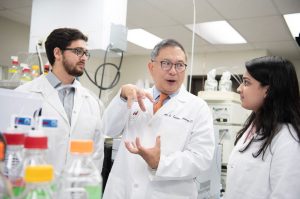Berunda Polypeptides: Biheaded Rapamycin Carriers for Subcutaneous Treatment of Autoimmune Dry Eye Disease
Molecular Pharmacy
Stan Louie et al.
2019
The USFDA-approved immunosuppressive drug rapamycin (Rapa), despite its potency, is limited by poor bioavailability and a narrow therapeutic index. In this study, we sought to improve bioavailability of Rapa with subcutaneous (SC) administration and to test its therapeutic feasibility and practicality in a murine model of Sjögren's syndrome (SS), a systemic autoimmune disease with no approved therapies. To improve its therapeutic index, we formulated Rapa with a carrier termed FAF, a fusion of the human cytosolic FK506-binding protein 12 (FKBP12) and an elastin-like polypeptide (ELP). The resulting 97 kDa FAF (i) has minimal burst release, (ii) is "humanized", (iii) is biodegradable, (iv) solubilizes two Rapa per FAF, and (v) avoids organic solvents or amphiphilic carriers. Demonstrating high stability, FAF remained soluble and monodisperse with a hydrodynamic radius of 8 nm at physiological temperature. A complete pharmacokinetic (PK) analysis of FAF revealed that the bioavailability of SC FAF was 60%, with significantly higher blood concentration during the elimination phase compared to IV FAF. The plasma concentration of Rapa delivered by FAF was 8-fold higher with a significantly increased plasma-to-whole blood ratio relative to free Rapa, 24 h after injection. To evaluate therapeutic effects, FAF-Rapa was administered SC every other day for 2 weeks to male non-obese diabetic (NOD) mice, which develop an SS-like autoimmune-mediated lacrimal gland (LG) inflammation and other characteristic features of SS. Both FAF-Rapa and free Rapa exhibited immunomodulatory effects by significantly suppressing lymphocytic infiltration, gene expression of IFN-γ, MHC II, type I collagen and IL-12a, and cathepsin S (CTSS) activity in LG compared to controls. Serum chemistry and histopathological analyses in major organs revealed no apparent toxicity of FAF-Rapa. Given its improved PK and equipotent therapeutic efficacy compared to free Rapa, FAF-Rapa is of further interest for systemic treatments for autoimmune diseases like SS.
Read More
Effect of Vitamin D Supplementation on Bone Turnover Markers During HIV Pre-Exposure Prophylaxis Using Tenofovir Disoproxil Fumarate-Emtricitabine in Men Who Have Sex with Men
AIDS Research and Human Retroviruses
Stan Louie et al.
2019
Pre-exposure prophylaxis (PrEP) with tenofovir disoproxil fumarate-emtricitabine (TDF-FTC) reduces bone mineral density in HIV-uninfected men who have sex with men (MSM). We hypothesized that PrEP with TDF-FTC would increase bone turnover markers (BTMs) at week 24 and that vitamin D supplementation from weeks 24 to 48 would blunt this increase. Participants were from a cohort of 398 MSM and transgender women who received daily TDF-FTC for PrEP. At week 24, a prospective intervention group initiated vitamin D3 4,000 IU daily. Concurrent controls were selected from the cohort who took ≤400 IU/day of vitamin D3 matched by age, race, and body mass index. The primary endpoint was the change in procollagen-I N-terminal propeptide (P1NP) from weeks 24 to 48. Paired t-tests were used to compare changes in BTMs between intervention and controls. Among 48 intervention-control pairs, median age was 33 years. At baseline, 68.9% of the intervention group and 77.3% of controls were vitamin D sufficient (≥20 ng/mL, p = .94). P1NP, C-telopeptide, parathyroid hormone (PTH), and 25-OH vitamin D3 did not increase significantly at week 24. P1NP fell by a mean ± SD of -27.6 ± 49.9 pg/mL from weeks 24 to 48 with vitamin D and -2.5 ± 40.2 pg/mL in controls (p = .01). There were no significant between-group differences in the weeks 24-48 change in C-telopeptide, PTH, or 25-OH vitamin D3. Vitamin D3 supplementation with 4,000 IU/day resulted in a significant reduction in the BTM P1NP compared with controls, suggesting that this intervention has potential to improve bone health during PrEP.
Read More
Circulating angiotensin peptides levels in Acute Respiratory Distress Syndrome correlate with clinical outcomes: A pilot study
PLoS One
Stan Louie et al.
2019
Thirty-nine ARDS patients were enrolled within 24 hours of ARDS diagnosis. Plasma RAS peptide levels were quantified at study entry and 24, 48 and 72 hours using a liquid chromatography-mass spectrometry based metabolomics assay. RAS peptide concentrations were compared between survivors and non-survivors, and were correlated with clinical and pulmonary measures.
Read More
Humanized Mouse Model of HIV-1 Latency with Enrichment of Latent Virus in PD-1+ and TIGIT+ CD4 T Cells
Journal of Virology
Stan Louie et al.
2019
Combination anti-retroviral drug therapy (ART) potently suppresses HIV-1 replication but does not result in virus eradication or a cure. A major contributing factor is the long-term persistence of a reservoir of latently infected cells. To study this reservoir, we established a humanized mouse model of HIV-1 infection and ART suppression based on an oral ART regimen. Similar to humans, HIV-1 levels in the blood of ART-treated animals were frequently suppressed below the limits of detection. However, the limited timeframe of the mouse model and the small volume of available samples makes it a challenging model with which to achieve full viral suppression and to investigate the latent reservoir. We therefore used an ex vivo latency reactivation assay that allows a semiquantitative measure of the latent reservoir that establishes in individual animals, regardless of whether they are treated with ART. Using this assay, we found that latently infected human CD4 T cells can be readily detected in mouse lymphoid tissues and that latent HIV-1 was enriched in populations expressing markers of T cell exhaustion, PD-1 and TIGIT. In addition, we were able to use the ex vivo latency reactivation assay to demonstrate that HIV-specific TALENs can reduce the fraction of reactivatable virus in the latently infected cell population that establishes in vivo, supporting the use of targeted nuclease-based approaches for an HIV-1 cure.
Read More
Changes in microbiome diversity following beta-lactam antibiotic treatment are associated with therapeutic versus subtherapeutic antibiotic exposure in cystic fibrosis
Scientific Reports
Stan Louie et al.
2019
In persons with cystic fibrosis (CF), decreased airway microbial diversity is associated with lower lung function. Conflicting data exist on the impact of short-term antibiotics for treatment of acute pulmonary exacerbations. However, whether differences in antibiotic exposure impacts airway microbiome changes has not been studied. We hypothesized that subtherapeutic beta-lactam antibiotic exposure, determined by the pharmacokinetics and pharmacodynamics (PK/PD) after intravenous (IV) antibiotic administration, would be associated with different patterns of changes in CF airway microbial diversity. Eligible children were enrolled when well; study assessments were performed around the time of pulmonary exacerbation. Plasma drug concentrations and bacterial minimum inhibitory concentrations (MICs) were used to determine therapeutic versus subtherapeutic beta-lactam antibiotic exposure. Respiratory samples were collected from children, and extracted bacterial DNA was amplified for the V4 region of the 16S rRNA gene. Twenty children experienced 31 APEs during the study; 45% (n = 14) of antibiotic courses were deemed therapeutic. Those in the therapeutic group had more significant decreases in alpha diversity at end of treatment and post-recovery compared to baseline than those in the subtherapeutic group. Therapeutic and subtherapeutic beta-lactam use is associated with different patterns of changes in CF airway microbial diversity following antibiotic administration.
Read More




